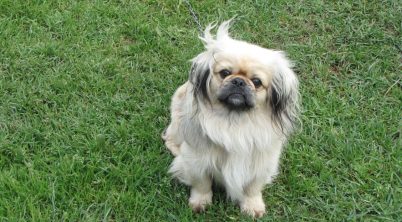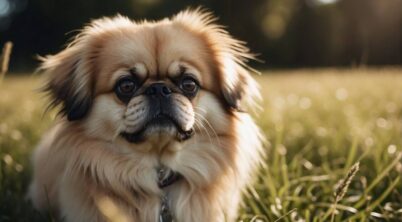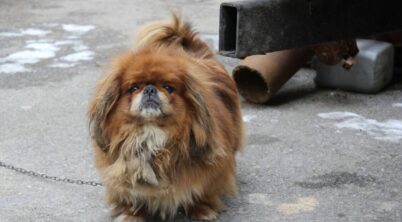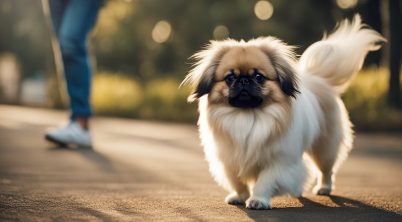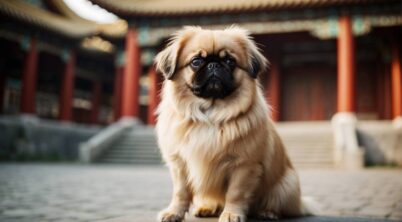The Pekingese is a dog breed steeped in history, originating from ancient China. They were once the cherished companions of Chinese royalty, a symbol of prestige and exclusivity. This toy breed, recognized for its distinct lion-like mane and regal demeanor, has maintained its status as a beloved lapdog through the centuries, prized as much for their loyalty as for their heritage. Their long-standing connection with the imperial family of China has imbued the Pekingese with an air of dignified confidence that belies their small stature.
Determining the intelligence of the Pekingese involves understanding their specific breed characteristics. As dogs bred primarily for companionship rather than for working or obedience roles, the Pekingese showcases a type of intelligence that is more in tune with social interaction and manipulation of their environment to suit their needs. Ranking in the middle range of canine intelligence assessments, the Pekingese is known for its capacity to learn a significant number of words and commands, but may require more repetitions to do so compared to more work-oriented breeds.
Despite not ranking at the top of ‘smartest dogs’ lists, the Pekingese demonstrates its intelligence through its resourceful nature in play and the ability to form strong bonds with their owners. Their affectionate and loyal temperaments coupled with an independent streak means that they often approach tasks in their own unique way, an attribute that Pekingese owners often find endearing and integral to the breed’s distinctive personality.
Table of Contents
How Smart Are Pekingese Dogs?
The Pekingese, an ancient breed originally bred for Chinese royalty, has an intelligence that is often perceived in terms of companionship rather than obedience or work. This breed is ranked as the 73rd smartest dog breed in terms of obedience and working intelligence. Intelligence in Pekingese manifests in their strong loyalty and affection, traits that resonate well with their history as lapdogs for aristocrats.
Learning Ability of the Pekingese:
- Repetitions to Learn New Commands: On average, 80 to 100 repetitions.
- Number of Words They Can Learn: Approximately 165 words, including signals.
Pekingese show a notable capacity for certain types of intelligence:
- Social Intelligence: They exhibit a high degree of loyalty and affection towards their owners.
- Adaptive Intelligence: Pekingese have shown the ability to manipulate situations to their advantage during play, indicating a form of problem-solving skill.
Despite these indicators of intelligence, the Pekingese may not excel in tasks that require immediate and unquestioning compliance, as obedience is not their strongest suit. Due to their breeding as companion animals rather than working dogs, they tend to be independent-minded.
Exercise Needs in Relation to Intelligence: Pekingese do not require extensive physical exercise and are known for being fairly active indoor. A short play session indoors or a mild walk outdoors is usually adequate for their needs. This breed is quite suited to living in smaller spaces such as apartments, and they can be happy and healthy with the proper amount of mental stimulation and affection.
Breed History and Origin
The Pekingese breed boasts a storied heritage deeply rooted in ancient China. Known for their lion-like appearance, these dogs are often referred to as lion dogs, symbolizing their historical connection to Chinese Buddhist culture, which associated them with the likeness of lions, animals that served as companions to Buddha. Their small stature stands in contrast to their bold and regal bearing, a physical embodiment of the dogs’ esteemed status in Chinese society.
Historically, the Pekingese were the cherished companions of Chinese royalty, held in such high regard that they became symbolic of the royal family’s divine mandate to rule. Exclusive to the imperial court, these dogs were bred and revered, encapsulating the opulence of their environment. Indeed, for centuries, ownership of a Pekingese outside the noble class was forbidden.
The lineage of the Pekingese is pure, tracing back to the canine denizens of the imperial palace in Beijing. They were an integral part of the pomp of court life, regarded as semi-divine beings, and their theft or sale was proscribed by severe penalties, even death. This sacred status underscored their significant role in the fabric of Chinese history and mythology.
It wasn’t until the Opium Wars of the 19th century that the Pekingese were introduced to the Western world. Most notably, five Pekingese were taken from the Summer Palace in Beijing and brought to England, where they quickly captured the hearts of the British aristocracy, leading to the breed’s spread beyond the confines of their native land.
Today, the Pekingese remain a testament to their ancient and noble lineage, retaining the dignified and confident demeanor that once graced the laps of emperors and princes of China.
Temperament and Personality
Pekingese dogs are known for their distinct temperament and personality that reflect their storied origins in Chinese royalty. They exhibit a blend of dignity and confidence with a loyal and affectionate nature towards their families.
Behavioral Traits
Pekingese are independent and opinionated, traits that often manifest as stubbornness. They are intelligent but may choose to use their smarts selectively, especially when it suits their own interests. Their alertness makes them excellent little watchdogs, often displaying a bark that belies their size. Despite their regal background, Pekingese can show a friendly and affectionate side, bonding closely with their owners.
- Independence: Strong-willed and self-sufficient; can be resistant to commands.
- Opinionated: They have their own ideas about how things should be done.
- Intelligence: Capable learners when engaged properly.
- Alert: Quick to notice unusual activities; can be relied on for vigilant monitoring.
- Friendliness: Warm and socially responsive when in a comfortable environment.
Interaction with Families and Children
With families, Pekingese show a remarkable degree of loyalty, often forming a strong attachment to one particular household member. They are confident in the presence of their family but may require a gentle approach from children due to their small size. Although not inherently unfriendly, their dignified nature means they may not tolerate overly boisterous behavior or rough play.
- Loyalty: Deeply loyal, creating lasting bonds with family members.
- Confidence: Display a sense of self-assuredness within the family unit.
- Dignified Interaction with Children: Prefer respectful interaction; best with older children who understand their needs.
Training and Exercise
Training Pekingese dogs requires patience and consistency due to their intelligence and independent nature. This breed may exhibit stubbornness, which can challenge the training process. Therefore, employing the right techniques is crucial. Their exercise needs are moderate, and daily walks suffice to keep them healthy and happy.
Training Techniques
The Pekingese can be difficult to train due to their smart yet willful disposition. Early socialization is imperative to cultivate a well-adjusted dog. Positive reinforcement is the most effective strategy, rewarding appropriate behavior with treats or praise.
- Begin Early: Introduce puppies to various experiences promptly.
- Maintain Consistency: Set rules and stick to them.
- Short Sessions: Keep training sessions brief to retain their attention.
- Stay Positive: Use rewards and encouragement to motivate them.
Exercise Requirements
Although the Pekingese isn’t a highly energetic breed, regular exercise is important to maintain their health. They do not require extensive physical activity, but daily walks and some playtime are essential.
- Daily Walks: At least one walk per day is recommended.
- Playtime: Engage in moderate play to stimulate their mind and body.
- Avoid Overexertion: Monitor for signs of fatigue, especially in hot weather, due to their sensitivity to heat.
In summary, the Pekingese benefits from specific training techniques focused on positive reinforcement and requires a manageable amount of daily exercise to stay fit and content.

